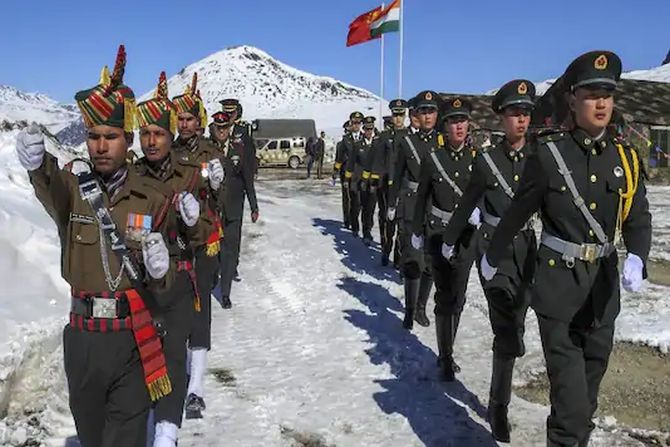India and China on Friday resolved to push ahead with ‘complete disengagement’ of troops in eastern Ladakh in a timely manner for ‘full restoration’ of peace and tranquility along the LAC even as Defence Minister Rajnath Singh undertook a comprehensive review of the situation following withdrawal of Chinese military from several friction points.
As Chinese troops continued to withdraw from Pangong Tso in eastern Ladakh, the two countries held another round of diplomatic talks, and decided that senior commanders of the two armies will meet ‘soon’ to discuss further steps to ‘ensure complete disengagement and de-escalation in a timely manner’.
Rajnath Singh also held a telephonic conversation with his US counterpart Mark T Esper during which the border row with China figured prominently, sources said.
China’s aggressive posturing along the Line of Actual Control (LAC) in eastern Ladakh was discussed, the sources said, adding Singh apprised the US defence secretary about India’s position on the row.
After the online diplomatic meeting under the framework of Working Mechanism for Consultation and Coordination (WMCC) on India-China Border Affairs, the Ministry of External Affairs (MEA) said the two sides agreed that maintenance of ‘enduring peace’ in the border areas was essential for overall development of bilateral ties.
The MEA said the two sides reaffirmed to ensure complete disengagement of the troops along the LAC for ‘full restoration’ of peace and tranquility in the border areas in accordance with bilateral agreements and protocols.
‘They also agreed that for the overall development of bilateral relations it was essential to maintain enduring peace and tranquillity in the border areas.
‘They reviewed the situation in the India-China border areas including the progress made in ongoing disengagement process along the LAC in the western sector,’ the MEA said in a statement.
In Beijing, the Chinese foreign ministry said both the sides affirmed the ‘positive progress’ made by their troops in easing the situation along the LAC in eastern Ladakh and agreed to continue the dialogue to further de-escalate the situation.
“They have agreed to continue to maintain dialogue and consultations on the military and diplomatic channels, promote further de-escalation of situation on the ground, and strengthen confidence-building measures in the border areas, properly handle border issues in a timely manner,” the ministry said in a statement.
The MEA in its statement said both sides agreed that it was necessary to sincerely implement the understandings reached between senior commanders.
In line with the first phase of the disengagement process from friction points, Chinese military on Thursday completed moving back its troops from the face-off sites in Gogra and Hot Springs, days after withdrawing all its personnel from the Galwan Valley, people familiar with the development said.
They said withdrawal of troops from Finger 4 area in Pangong Tso is also gaining traction, paving the way for holding of another round of Corps commander level talks in the next few days to further de-escalate tension in the region.
The formal disengagement process began on Monday morning after a nearly two-hour telephonic conversation between National Security Advisor Ajit Doval and Chinese Foreign Minister Wang Yi on Sunday.
In Friday’s talks, both sides recalled the agreement reached between the foreign ministers of the two countries in their talks on June 17 as well as outcome of negotiations between Doval and Wang, the Special Representatives (SRs) on the boundary issue.
‘As agreed by the two SRs, the senior commanders will meet soon to discuss further steps so as to ensure complete disengagement and de-escalation in a timely manner.
‘The two sides also agreed to maintain the ongoing communication both at the diplomatic and military level to ensure early resolution of the situation,’ the MEA statement said.
Naveen Srivastava, Joint Secretary (East Asia) in the External Affairs Ministry, led the Indian delegation at the talks while the Chinese side was headed by Wu Jianghao, Director General in the Chinese foreign ministry.
Amid the talks, Chinese Ambassador to India Sun Weidong, in a video statement, said the two countries should build mutual trust and should not allow differences to interfere with bilateral relations, adding both sides should work together to maintain peace and tranquility in the border areas. He also said China and India should be partners, rather than rivals.
In its statement, the MEA said both sides agreed to hold another meeting of the WMCC in the near future.
Defence Minister Singh carried out a review of the situation in eastern Ladakh at a meeting with Chief of Defence Staff General Bipin Rawat, Army Chief Gen M M Naravane, Navy Chief Admiral Karambir Singh and Air Chief Marshal RKS Bhadauria besides several other senior military officials.
Gen Naravane gave a detailed account of the implementation of the first phase of mutual disengagement of troops from Galwan Valley, Gogra, Hot Springs and Finger 4 areas in Pangong Tso, sources said.
The Indian and Chinese armies were locked in the bitter standoff in multiple locations in eastern Ladakh for the last eight weeks.
The tension escalated manifold after the Galwan Valley clashes in which 20 Indian Army personnel were killed.
Both sides have held several rounds of diplomatic and military talks in the last few weeks to ease tension in the region.
However, there was no visible sign of any end to the standoff till Sunday evening.
On June 30, the Indian and Chinese armies held the third round of Lt General-level talks during which both sides agreed on an ‘expeditious, phased and step wise’ de-escalation as a ‘priority’ to end the standoff.
The first round of the Lt General talks was held on June 6 during which both sides finalised an agreement to disengage gradually from all the standoff points beginning with Galwan Valley. However, the situation deteriorated following the Galwan Valley clashes as the two sides significantly bolstered their deployments in most areas along the LAC.
Tensions had escalated in eastern Ladakh around two months back after around 250 Chinese and Indian soldiers were engaged in a violent face-off on May 5 and 6. The incident in Pangong Tso was followed by a similar incident in north Sikkim on May 9.




